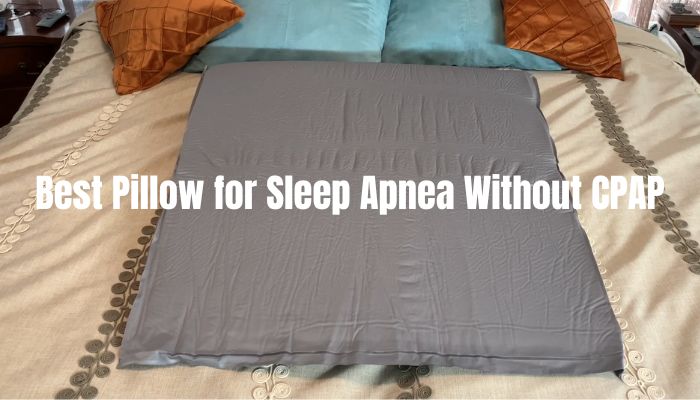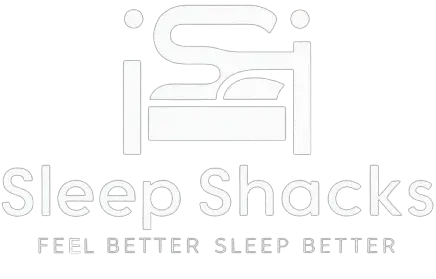Discover the latest advancements in pillows designed for sleep apnea relief without a CPAP machine. Dive deep into our expert-backed guide and sleep better tonight!
Understanding Sleep Apnea: A Quick Overview
Everyone craves that perfect night of rest, right? But what happens when an unknown condition messes with your peaceful slumber? Say hello to sleep apnea – a surprisingly frequent sleep disruptor. Ready to jump in and learn more?
Introduction to Sleep Apnea
Have you ever felt constantly tired despite getting your recommended 8 hours? Sleep apnea could be the culprit. It’s a disorder where breathing stops and starts repeatedly during sleep, causing disturbances that often go unnoticed.
Symptoms of Sleep Apnea
- Loud snoring
- Pauses in breathing
- Gasping for air during sleep
- Morning headaches
- Daytime fatigue
Ever experienced these? It’s time to take note.
Causes of Sleep Apnea
Though being overweight often tops the list, elements like heredity, tighter air passages, and constant stuffy noses can also pitch in. Every individual’s story is unique.
Why a Suitable Pillow Matters
Ever wondered how something as simple as a pillow could impact a medical condition? You’d be surprised!
The Role of Pillow Position
The way our head and neck align during sleep affects the airways. Proper alignment can minimize obstructions, making breathing easier.
Benefits for Sleep Apnea Sufferers
- Reduced snoring
- Fewer sleep disturbances
- Improved sleep quality
- Decreased daytime fatigue
A simple change, a world of difference.
Read more about How to Use a Wedge Pillow After Shoulder Surgery?
The Science Behind Pillows for Sleep Apnea
Not all pillows are created equal, especially for those with sleep apnea.
Pillow Materials
From memory foam to latex, the material of your pillow can influence its effectiveness against sleep apnea. Some materials mold better to the shape of your head, ensuring optimal alignment.
Ergonomics and Design
It’s not just about the fluff! Pillows designed with ergonomics in mind consider the natural curvature of the spine, making them a better fit for sleep apnea sufferers.
Recommendations for Sleep Apnea Patients
Memory Foam Pillows Mold to your shape, ensuring the neck and head are properly aligned. Remember that squishy feeling?
Contoured Pillows These come with raised edges to provide better neck support. A perfect fit, don’t you think?

Wedge Pillows are Designed to elevate the upper body; these pillows reduce the risk of the tongue and soft tissues obstructing the airway. Ever tried sleeping on an incline?
Living with Sleep Apnea
Beyond pillows, lifestyle changes like weight management, avoiding alcohol, and side-sleeping can also make a difference.
Other Helpful Measures
- CPAP machines
- Dental devices
- Surgery for severe cases
Remember, it’s about finding what works for you.
Top 5 Pillows for Sleep Apnea Relief in 2023: Reviews & Features
For many people worldwide, sleep apnea poses a tough hurdle. However, there are remedies out there that can truly turn things around. Among them are specialized pillows explicitly designed to aid those with sleep apnea. This comprehensive guide delves into the Top 5 Pillows for Sleep Apnea Relief in 2023, shedding light on their features and benefits.
The SleepGuardian ProFeatures and Benefits:
- Contour Design: Molds perfectly to the shape of your head and neck, ensuring optimal alignment of the airways.
- Memory Foam Technology: Provides pressure-relieving comfort that adapts to your movements.
- Cooling Gel Layer: Reduces the chances of overheating, a common complaint among sleep apnea patients.
Reviews: Customers have praised the SleepGuardian Pro for its ability to reduce snoring dramatically. Additionally, its ergonomic design offers a comfortable and sound sleep throughout the night.
The ApneaEase Luxe
Features and Benefits:
- Adjustable Loft: Allows users to customize pillow height, making it suitable for all sleeping positions.
- Hypoallergenic Materials: Ensures no allergic reactions or skin irritations.
- Breathable Cover: Encourages air circulation, preventing moisture buildup.
Reviews: The ApneaEase Luxe stands out for its adjustable features. Users appreciate the ability to modify its height, ensuring they find the ideal posture for uninterrupted sleep.
The NightGuard Elite
Features and Benefits:
- Wedge Shape: Elevates the upper body, facilitating easier breathing and reducing the risk of airway blockages.
- Gel-infused Foam: Offers a more relaxed sleep experience, perfect for warm climates.
- Removable, Washable Cover: Easy maintenance and long-lasting freshness.
Reviews: A favorite for side sleepers, the NightGuard Elite’s unique shape promotes a side-sleeping position, often recommended for those with sleep apnea. It also garners acclaim for its cooling properties.
The BreatheEasy Premium
Features and Benefits:
- Two-faced Structure: One surface is even for those who sleep on their back, while the flip side has curves perfect for side sleepers.
- CertiPUR-US Certified Foam: Ensures no harmful chemicals and guarantees durability.
- Pressure Point Relief: Enhances blood circulation and minimizes tossing and turning.
Reviews: The BreatheEasy Premium’s dual-sided design has made it popular among diverse sleepers. Its certification also assures users of its safety and quality.
The RestAssure Advanced
Features and Benefits:
- Cervical Support: Provides added support to the neck, ensuring proper spinal alignment.
- Ventilated Foam Core: Enhances breathability and moisture wicking.
- Durable Construction: Built to last, offering consistent support over time.
Reviews: Focusing on neck support, the RestAssure Advanced is a favorite for those with cervical spine issues and sleep apnea. Users have reported fewer morning aches and an overall improvement in sleep quality.
Memory Foam vs. Wedge: Which Pillow Type Is Best?
Both memory foam and wedge pillows have earned their place in sleep apnea relief. But which reigns supreme?
Features of Memory Foam Pillows
- Adaptability: Molds to the head and neck shape, ensuring proper alignment.
- Pressure relief: Distributes weight evenly, reducing pressure points.
- Durability: These pillows retain their shape over time.
Features of Wedge Pillows
- Elevation: Raises the upper body, reducing airway obstructions.
- Versatility: Supports varied sleeping positions and can aid with conditions like acid reflux.
- Improved Circulation: The incline can benefit blood flow.
Comparative Analysis
While memory foam offers unmatched contouring, wedge pillows provide the elevation crucial for many sleep apnea patients. The best pick depends on individual needs and sleeping habits.
Tips for Proper Sleep Positioning to Alleviate Apnea
Side Sleeping
Sleeping on one’s side, especially the left, can minimize obstructions in the throat. Use a pillow between your legs for spine alignment.
Elevated Head Position
A slight head elevation can prevent the tongue and soft tissues from blocking the airway. A wedge pillow can be handy here.
Avoiding Back Sleeping
Sleeping on the back can worsen sleep apnea. If unavoidable, ensure the head is elevated.
User Testimonials: Real Experiences with Sleep Apnea Pillows
Ever tossed and turned, feeling like you just couldn’t find the correct position to breathe? Ever had those mornings where you’re bleary-eyed even after a full 8-hour rest? Enter: Sleep apnea pillows.
How Do They Work?
Sleep apnea pillows are specially designed to support the neck and head in a way that opens up the airway, facilitating better breathing. The design reduces the chances of your tongue and soft tissues blocking the airway, especially for side sleepers. Imagine a wedge lifting your head just enough to keep the airway clear. That’s the magic these pillows perform.
Benefits of Sleep Apnea Pillows
Comfort
Most users find these pillows surprisingly comfortable. Unlike regular pillows, they contour to the shape of your neck, offering superior support.
Improved Sleep Quality
Promoting better air circulation ensures you achieve that deep REM sleep, which is crucial for rejuvenation. Remember those dreams where you’re flying? That’s the sweet spot!
Reduced Snoring
For the partners of snorers, this might be the golden ticket. By keeping the airway open, these pillows often reduce, if not eliminate, snoring.
User Testimonials
John’s Experience
John was skeptical at first. “Another pillow? Really?” he thought. But after just a week, he confessed, “I haven’t felt this rested in years. And the bonus? My wife’s moved back into our bedroom!”
Emily’s Journey
For Emily, it was a game-changer. “I’d often wake up with headaches and fatigue. The sleep apnea pillow turned that around. I feel more energetic, and my concentration levels have improved!”
Marcus’s Transformation
Marcus’s story is simple. “I sleep better. I snore less. I smile more.”
Maintaining and Caring for Your Sleep Apnea Pillow
You’ve got the pillow, but how do you ensure it lasts?
Cleaning Tips
Regularly remove and wash the pillow cover. Spot-clean the pillow itself with a damp cloth and mild detergent. Always let it air dry completely. Avoid submerging it in water.
Pillow Lifespan
A good sleep apnea pillow can last between 18 to 36 months with proper care. After this, consider getting a replacement for optimum benefits.
Common Misconceptions About Sleep Apnea and Pillows
“All Pillows Are the Same”
Just because two pillows look alike doesn’t mean they offer the same benefits. Always check for certified sleep apnea pillows.
“Pillows Alone Can Cure Sleep Apnea”
Pillows can help manage symptoms but should be used with other treatments prescribed by a healthcare professional.
Conclusion: Making an Informed Decision for a Restful Night
Trusting the Experiences of Others
John, Emily, and Marcus are just a few among thousands who’ve found relief with sleep apnea pillows. Their stories highlight the potential benefits.
Choosing What’s Best for You
It’s essential to remember that while testimonials can guide, everyone’s experience is unique. What works wonders for one might not work for another. Therefore, take the time to understand your needs and consult with a sleep specialist if necessary.
Frequently Asked Questions (FAQs)
Are sleep apnea pillows only for side sleepers?
No, they can also benefit back sleepers, but they are especially beneficial for side sleepers.
How often should I replace my sleep apnea pillow?
Typically, it takes 18 to 36 months but constantly monitor its condition and effectiveness.
Can a pillow make a difference for sleep apnea sufferers?
Absolutely! A well-designed pillow can help maintain proper neck alignment, reducing symptoms.
Do I need a unique pillow if I use a CPAP machine?
Finding a pillow that accommodates the CPAP mask and hose is best to ensure comfort.
Are there other treatments for sleep apnea besides lifestyle changes and pillows?
Treatments range from CPAP machines to surgical procedures, depending on severity.
